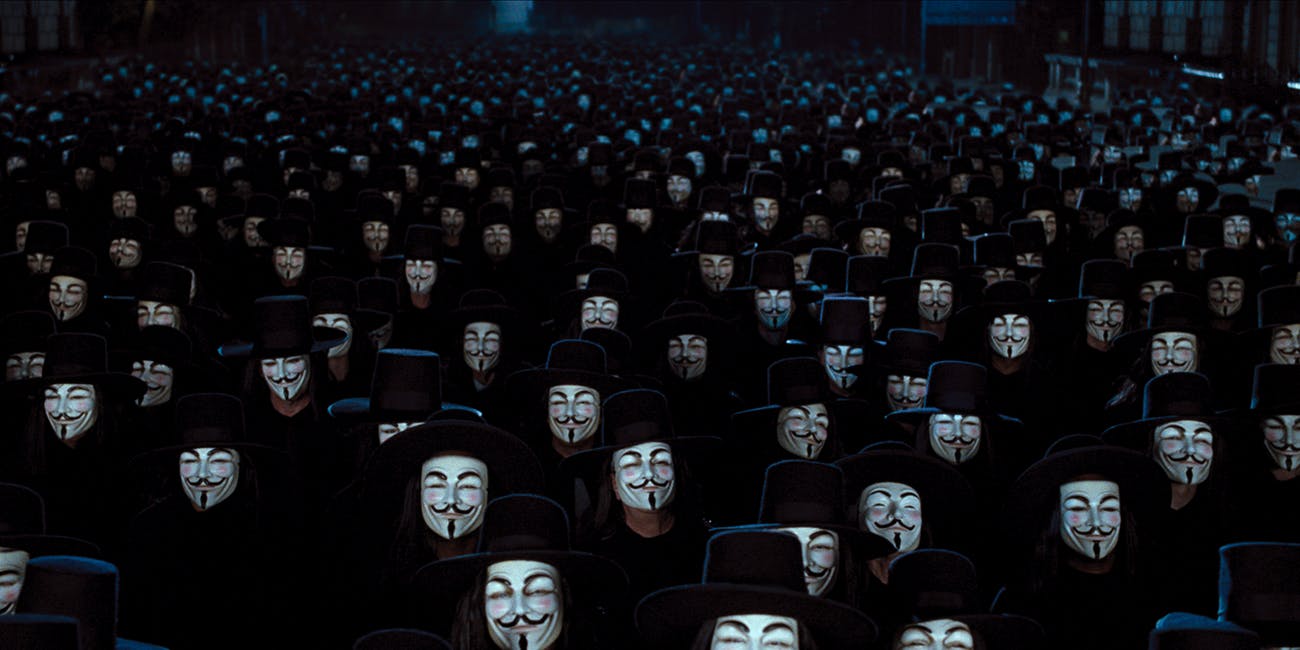V for Vendetta is a British graphic novel written by Alan Moore and illustrated by David Lloyd (with additional art by Tony Weare). Initially published, starting in 1982, in black-and-white as an ongoing serial in the short-lived UK anthology Warrior, it morphed into a ten-issue limited series published by DC Comics. Subsequent collected editions have been typically published under DC’s more specialized imprint, Vertigo. The story depicts a dystopian and post-apocalyptic near-future history version of the United Kingdom in the 1990s, preceded by a nuclear war in the 1980s that devastated most of the rest of the world. The white supremacist, neo-fascist, outwardly Christofascistic, and homophobic fictional Norsefire political party has exterminated its opponents in concentration camps, and now rules the country as a police state.
The comics follow the story’s title character and protagonist, V, an anarchist revolutionary dressed in a Guy Fawkes mask, as he begins an elaborate and theatrical revolutionist campaign to kill his former captors, bring down the fascist state, and convince the people to abandon fascism in favour of anarchy, while inspiring a young woman, Evey Hammond, to be his protégée.
DC Comics sold more than 500,000 copies of the graphic novel in the United States by 2006. Warner Bros. released a film adaptation of the same name in 2005.

The first episodes of V for Vendetta appeared in black-and-white between 1982 and 1985, in Warrior, a British anthology comic published by Quality Communications. The strip was one of the least popular in that title; editor/publisher Dez Skinn remarked, “If I’d have given each character their own title, the failures would have certainly outweighed the successes, with the uncompromising ‘V for Vendetta’ probably being an early casualty. But with five or six strips an issue, regular only needed two or three favorites to justify their buying the title.”
When the publishers cancelled Warrior in 1985 (with two completed issues unpublished due to the cancellation), several companies attempted to convince Moore and Lloyd to let them publish and complete the story. In 1988, DC Comics published a ten-issue series that reprinted the Warrior stories in colour, then continued the series to completion. The first new material appeared in issue No. 7, which included the unpublished episodes that would have appeared in Warrior No. 27 and No. 28. Tony Weare drew one chapter (“Vincent”) and contributed additional art to two others (“Valerie” and “The Vacation”); Steve Whitaker and Siobhan Dodds worked as colourists on the entire series.
David Lloyd’s paintings for V for Vendetta in Warrior first appeared in black and white.
Cover of Warrior #19, highlighting the comic’s conflict between anarchist and fascist philosophies.
In writing V for Vendetta, Moore drew upon a comic strip idea submission that the DC Thomson scriptwriting competition rejected in 1975. “The Doll” involved a transsexual terrorist in white face makeup who fought a totalitarian state during the 1980s.
Years later, Skinn reportedly invited Moore to create a dark mystery strip with artist David Lloyd. V for Vendetta was intended to recreate something similar to their popular Marvel UK Night Raven strip in a 1930s noir. They chose against doing historical research and instead set the story in the near future rather than the recent past.
Then V for Vendetta emerged, putting the emphasis on “V” rather than “Vendetta”. David Lloyd developed the idea of dressing V as Guy Fawkes after previous designs followed the conventional superhero look. During the preparation of the story, Moore made a list of what he wanted to bring into the plot, which he reproduced in “Behind the Painted Smile”:
Orwell. Huxley. Thomas Disch. Judge Dredd. Harlan Ellison’s “Repent, Harlequin!” Said the Ticktockman, Catman and The Prowler in the City at the Edge of the World by the same author. Vincent Price’s Dr. Phibes and Theatre of Blood. David Bowie. The Shadow. Night Raven. Batman. Fahrenheit 451. The writings of the New Worlds school of science fiction. Max Ernst’s painting “Europe After the Rain”. Thomas Pynchon. The atmosphere of British Second World War films. The Prisoner. Robin Hood. Dick Turpin…
The influence of such a wide number of references has been thoroughly demonstrated in academic studies, above which dystopian elements stand out, especially the similarity with George Orwell’s Nineteen Eighty-Four in several stages of the plot.
The political climate of Britain in the early 1980s also influenced the work, with Moore positing that Margaret Thatcher’s Conservative government would “obviously lose the 1983 elections”, and that an incoming Michael Foot-led Labour government, committed to complete nuclear disarmament, would allow the United Kingdom to escape relatively unscathed after a limited nuclear war. However, Moore felt that fascists would quickly subvert a post-holocaust Britain. V, an anarchist, initially murders members of the fascist government, but as the story develops, Moore deliberately made V’s actions “very, very morally ambiguous” with the aim that “I didn’t want to tell people what to think, I just wanted to tell people to think.”
Moore’s scenario remains untested. Addressing historical developments when DC reissued the work, he noted:
Naïveté can also be detected in my supposition that it would take something as melodramatic as a near-miss nuclear conflict to nudge Britain towards fascism… The simple fact that much of the historical background of the story proceeds from a predicted Conservative defeat in the 1983 General Election should tell you how reliable we were in our roles as Cassandras.
source : wikipedia.org
 Free Chrome New Tab Extensions Chrome New Tab serves free extensions for the Google Chrome web browser. Customize your browser's new tab page and display different wallpapers each run.
Free Chrome New Tab Extensions Chrome New Tab serves free extensions for the Google Chrome web browser. Customize your browser's new tab page and display different wallpapers each run.



